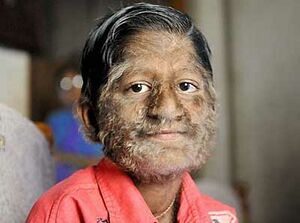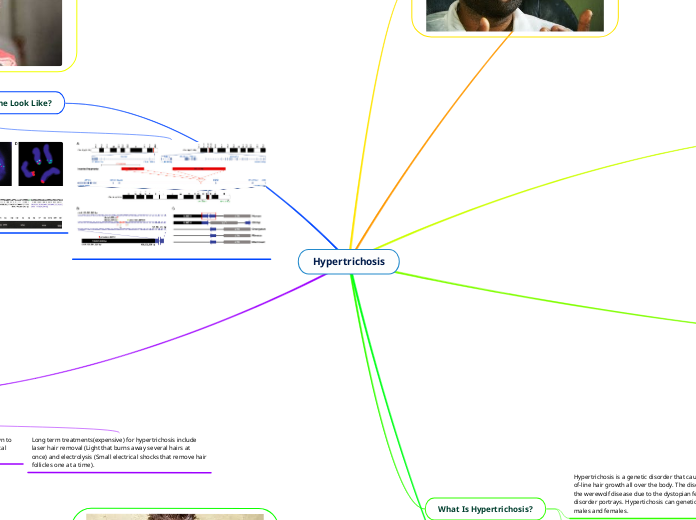Hypertrichosis
Relating Facts Or Interests:
I find the comparison of someone with hypertrichosis and the fictional werewolf concept to be very fitting in terms of characteristics.
Hypertrichosis is something that has had a trend of winding up in olden style circus displays.
Children with hypertrichosis are said to miss out on a lot of crucial developmental phases, like forming friendships and participating in things of personal interest.
Hypertrichosis vs. Hirsutism
Hirsutism is something mostly caused by hormonal diseases, and it only affects females, which is different from hypertrichosis.
Hypertrichosis affects the whole body, wherus hirsutism only affects areas dependent on growth hormones', or androgen-dependent areas.
Hirsutism can be managed with topical creams in such, and people affected appreciate this as it means they wont have to wax a beard off their face.
Research being done on it:
Hypertrichosis has been discovered to be a phenotype through and through.
Researchers have delved into the specifics of the hair type, the pigments, thinness, density etc.
Isolated hypertrichosis is the rarest form of the disorder, meaning the mutation is an extremely rare occurrence and hypertrichosis is more often a heritage passed disorder.
A well known theory on how hypertrichosis came to be is that a proposed conversion of vellus hair to terminal hair made it so that changes in the growth cycle occurred, making follicles spend more time in the anagen phase and spreading and multiplication occur as a increase in follicular density.
Hypertrichosis also affects organ systems.
Most affected areas are the head and neck.
The odds of someone having some form of hypertrichosis is 1.3/2000 people.
What Is Hypertrichosis?
Hypertrichosis is a genetic disorder that causes extreme out-of-line hair growth all over the body. The disorder is nicknamed the werewolf disease due to the dystopian feel that the disorder portrays. Hypertichosis can genetically occur in both males and females.
Hypertrichosis can occur both at birth and after birth; Activated(cognitive) or acquired.
Whats the history?
Awareness of Hypertrichosis is seen to come up as far back as 1642, written and published by Ulisse Aldrovandi. There were also paintings of the family that could be seen in the Ambras Castle.
The first case looked to be a family condition, where the father(Petrus Gonsalvus), his 2 daughters, his son, and one of his grandchildren all had this shocking werewolf look to them.
Since 1642, only 50 cases have been reported on and studied leading up to 2022.
What Does The Gene Look Like?



Treatments:
Hypertrichosis is uncurbable, and there is no ways as of now that can prevent the cognitive form of the disorder.
The acquired form however, can have the chances lowered by taking precautions when taking certain medications, such as avoiding the consumption of minoxidil.
Normal and affordable treatments, all of which are shown to be short term for hypertrichosis, include shaving, chemical epilation, waxing, plucking, and hair bleeching.
Long term treatments(expensive) for hypertrichosis include laser hair removal (Light that burns away several hairs at once) and electrolysis (Small electrical shocks that remove hair follicles one at a time).
Causes of Hypertrichosis:
In cognitive hypertrichosis, the kind that shows up from birth, is theorized to be caused by overabundance/over activity of the genes that stimulate hair growth. Over the years of observation, there is still no known cause of this.
In acquired hypertrichosis, the kind that activates after birth, there are many different causes. These causes include malnutrition, poor diets, eating disorders, hair growth drugs, certain immunosuppressants, androgenic steroids, cancer and cell mutation, and autoimmune + infectious diseases that affect the skin. Sometimes having porphyria cutanea trada can also trigger hypertrichosis when they are irritated by UV lights.
Help groups for Hypertrichosis:
I couldn't find anything local, but there was a help group for hypertrichosis cubiti, which is specific to hair growth on the elbows and areas surrounding them. The groups aren't specific to hypertrichosis cubiti, instead they revolve around people with Ectodermal dysplasia.
Link 3


